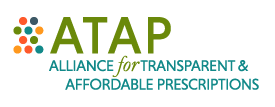ATAP Responds to White House Report on Drug Pricing Reform
The Alliance for Transparent & Affordable Prescriptions (ATAP) applauds the White House for recognizing the increasingly harmful role of pharmacy benefit managers (PBMs) in the prescription drug market in a report released Friday outlining policy options to reduce drug prices and encourage medical innovation.
Prescription drug affordability is a top concern for Americans. As a coalition of physicians and patient advocates, our mission is to make medications more affordable and accessible. By educating lawmakers about PBMs—the middlemen hired by insurers to manage drug benefit programs—and their role in raising drug prices, ATAP seeks to give a voice to the patients hurt by this country’s broken drug system.
After dozens of correspondences and meetings with members of Congress and government officials, we are thrilled that the White House has acknowledged a few key problems caused by PBMs and included in the report specific ATAP policy recommendations, including enhancing competition in the PBM market and mandatory pass-through of discounts to patients.
One such problem noted in the report occurs in the Medicare Part D Program: “The overall Part D benefit structure creates perverse incentives for plan sponsors and pharmacy benefit managers (PBMs) to generate formularies that favor high-price, high-rebate drugs that speeds patients through the early phases of the benefit structure where plans are most liable for costs.” The report suggests implementing a mandatory rebate pass-through requirement and policies to discourage formulary design that speeds patients to the catastrophic coverage phase as potential solutions, mirroring recommendations put forth by ATAP in multiple comment letters to the Centers for Medicare & Medicaid Services (CMS) and in discussions with policymakers.
Significantly, the report also recognizes the impact of PBM market concentration and significant lack of transparency on patients:
Three PBMs account for 85 percent of the market, which allows them to exercise undue market power against manufacturers and against the health plans and beneficiaries they are supposed to be representing, thus generating outsized profits for themselves. Over 20 percent of spending on prescription drugs was taken in as profit by the pharmaceutical distribution system. The size of manufacturer rebates and the percentage of the rebate passed on to health plans and patients are secret. The system encourages manufacturers to set artificially high list prices, which are reduced via manufacturers’ rebates but leave uninsured individuals facing high drug prices.
To increase competition and further reduce costs for patients, the report suggests implementing policies that are designed to decrease concentration in the PBM market. Fortunately, many of ATAP’s policy recommendations are aimed at addressing just that. ATAP welcomes the opportunity to further collaborate with the White House and members of Congress on developing specific solutions.
In all, the White House report is just the latest sign that ATAP’s advocacy and extensive outreach is resonating with policymakers. The White House has taken a step in the right direction, and ATAP looks forward to continuing to work with legislators and officials to prioritize patients.
